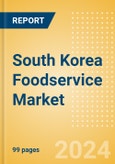“South Korea Foodservice Market Size and Trends by Profit and Cost Sector Channels, Players and Forecast to 2027” provides extensive insight and analysis of the South Korean Foodservice market over the next five years (2022–27) and acts as a vital point of reference for operators or suppliers.
The South Korean profit sector’s revenue reached KRW131.1 trillion ($101.5 billion) in 2022, yielding a marginal CAGR of 0.3% over 2017–22. The slow growth can be attributed to the country’s rising inflation, which negatively impacted profit sector sales. However, rising tourism aided demand for foodservice.
FSR was the largest foodservice profit sector channel in 2022, with a value share of 59.2%. QSR was the second-largest channel in the year, generating 12.6% of overall profit sector value. Coffee & tea shop was the third-largest channel in 2022. During 2017–22, the travel and leisure channels registered sharp declines in value sales, decreasing at negative CAGRs of 14.6% and 11.8%, respectively, due to cross-border restrictions leading to reduced tourist inflow. During 2022–27, the South Korean profit sector will register a strong value CAGR of 6.4%.
The South Korean profit sector’s revenue reached KRW131.1 trillion ($101.5 billion) in 2022, yielding a marginal CAGR of 0.3% over 2017–22. The slow growth can be attributed to the country’s rising inflation, which negatively impacted profit sector sales. However, rising tourism aided demand for foodservice.
FSR was the largest foodservice profit sector channel in 2022, with a value share of 59.2%. QSR was the second-largest channel in the year, generating 12.6% of overall profit sector value. Coffee & tea shop was the third-largest channel in 2022. During 2017–22, the travel and leisure channels registered sharp declines in value sales, decreasing at negative CAGRs of 14.6% and 11.8%, respectively, due to cross-border restrictions leading to reduced tourist inflow. During 2022–27, the South Korean profit sector will register a strong value CAGR of 6.4%.
The report includes -
- Overview of South Korea's macro-economic landscape: Detailed analysis of current macro-economic factors and their impact on the South Korean foodservice market including GDP per capita, consumer price index, population growth, and annual household income distribution.
- Growth dynamics: In-depth data and forecasts of key channels (QSR, FSR, coffee & tea shop, and pub, club & bar) within the South Korean foodservice market, including the value of the market, number of transactions, number of outlets and average transaction price.
- Customer segmentation: Identify the most important demographic groups, buying habits, and motivations that drive out-of-home meal occasions among segments of the South Korean population.
- Key players: Overview of market leaders within the four major channels including business descriptions and number of outlets.
Scope
South Korea registered GDP per capita growth of 4.2% in 2022. South Korea’s GDP growth rate declined from 4.1% in 2021 to 2.6% in 2022. The working-age population accounted for 70.7% of the total population of South Korea in 2022. The South Korean profit sector’s revenue reached KRW131.1 trillion ($101.5 billion) in 2022, yielding a marginal CAGR of 0.3% over 2017–22. FSR was the largest foodservice profit sector channel in 2022, with a value share of 59.2%. This reflects the popularity of traditional fine-dining experiences among South Korean consumers. QSR was the second-largest channel in 2022, accounting for 12.6% of overall profit sector value. The ice cream parlor channel had the highest proportion of chain restaurants in 2022, with these accounting for 87.3% of total channel revenue.Reasons to Buy
- Specific forecasts of the foodservice market over the next five years (2022–27) will give readers the ability to make informed business decisions through identifying emerging/declining markets.
- Consumer segmentation detailing the desires of known consumers among all major foodservice channels (QSR, FSR, coffee & tea shop, and pub, club & bar) will allow readers understand the wants and needs of their target demographics.
Table of Contents
- Introduction
- Report Guide
- Executive Summary
- Macroeconomic Context
- Macroeconomic Overview
- Trends Landscape
- Profit Sector - Impact of COVID-19
- Profit Sector Metrics
- Key Metric Highlights
- Value Share and Growth by Channel
- Outlets and Transactions Growth by Channel
- Operator Buying Volumes and Growth by Channel
- Channel Historic and Future Growth Dynamics
- Outlet-Type and Owner-Type Growth Dynamics
- Quick-Service Restaurant (QSR)
- Summary & Key Points
- Metrics
- Key Players
- Who?
- Why?
- What?
- Where?
- What Next?
- Full-Service Restaurant (FSR)
- Summary & Key Points
- Metrics
- Key Players
- Who?
- Why?
- What?
- Where?
- What Next?
- Coffee & Tea Shop
- Summary & Key Points
- Metrics
- Key Players
- Who?
- Why?
- What?
- Where?
- What Next?
- Pub, Club & Bar
- Summary & Key Points
- Metrics
- Who?
- Why?
- What?
- Where?
- What Next?
- Contact the Publisher
Companies Mentioned (Partial List)
A selection of companies mentioned in this report includes, but is not limited to:
- McDonald’s
- BHC Chicken
- Restaurant Brands International
- Nonghyup Mokwoochon
- Issac Toast
- Bon IF
- Outback Steakhouse
- Nolboo
- Starbucks
- The Carlyle Group
- Dunkin’ Brands
- Lotte Group








